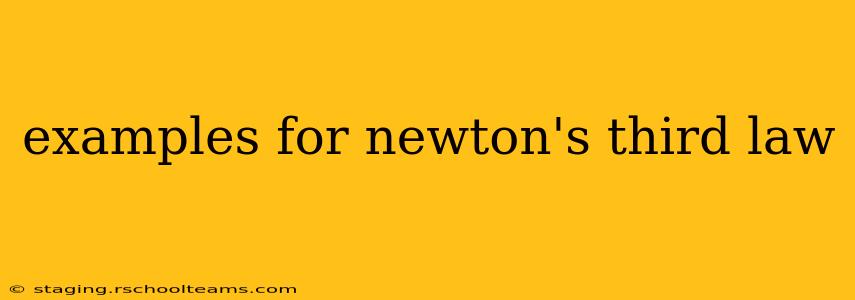Newton's Third Law of Motion, often simplified to "for every action, there's an equal and opposite reaction," is a fundamental principle governing how objects interact. Understanding this law requires recognizing that forces always come in pairs. These pairs act on different objects, not the same object. Let's explore some compelling examples to solidify this concept.
Everyday Illustrations of Action-Reaction Pairs
We encounter Newton's Third Law constantly, often without realizing it. Here are some relatable examples:
1. Walking: A Complex Interaction of Forces
When you walk, you push backward on the ground (action). The ground, in turn, pushes forward on your feet with an equal and opposite force (reaction). This forward force propels you forward. Without the ground pushing back, you wouldn't be able to move!
2. Swimming: Propelling Through Water
Swimming utilizes a similar principle. You push backward against the water (action), and the water pushes you forward (reaction). The faster and stronger your push, the greater the forward force, resulting in faster swimming.
3. Rocket Launch: Escaping Earth's Gravity
A rocket launch provides a dramatic example. The rocket expels hot gases downward (action), and the gases exert an equal and opposite upward force on the rocket (reaction). This upward force overcomes gravity, allowing the rocket to ascend.
4. Jumping: Overcoming Your Inertia
When you jump, you push down on the Earth (action). Simultaneously, the Earth pushes up on you with an equal force (reaction). This upward force propels you into the air. The Earth's massive size means the Earth's acceleration is negligible, but the force is undeniably present.
5. Hitting a Baseball: Transfer of Momentum
When a baseball bat hits a baseball, the bat exerts a force on the ball (action), sending it flying. Concurrently, the ball exerts an equal and opposite force on the bat (reaction), causing a slight recoil or "sting" in the batter's hands.
6. Rowing a Boat: Moving Through Water
Rowing a boat showcases a clear action-reaction pair. The oars push against the water (action), and the water pushes back on the oars (and thus, the boat) (reaction), moving the boat forward.
Misconceptions About Newton's Third Law
It's important to clarify some common misunderstandings:
- Equal and opposite forces don't cancel each other out: The action and reaction forces act on different objects. They don't cancel because they are not acting on the same object.
- The forces are always simultaneous: Action and reaction occur at precisely the same time. One cannot happen without the other.
Conclusion: Understanding the Universal Law of Interaction
Newton's Third Law is a cornerstone of classical mechanics, explaining countless interactions in our daily lives, from the seemingly simple act of walking to the powerful launch of a rocket. By understanding the action-reaction principle, we gain a deeper appreciation for the fundamental forces governing the physical world. Observing these examples keenly will solidify your grasp of this crucial law of physics.
